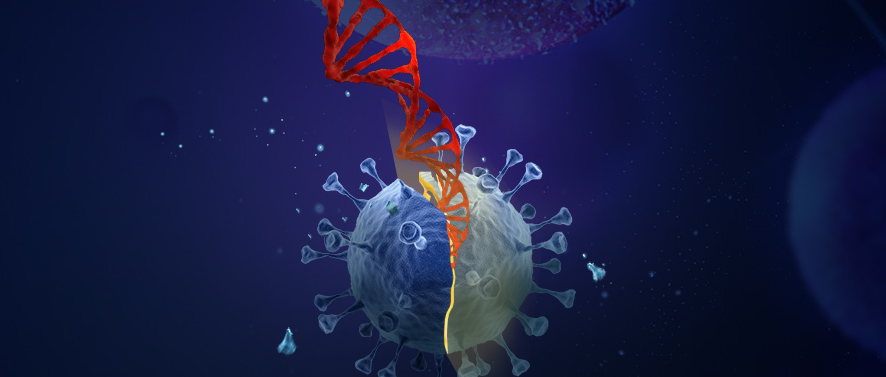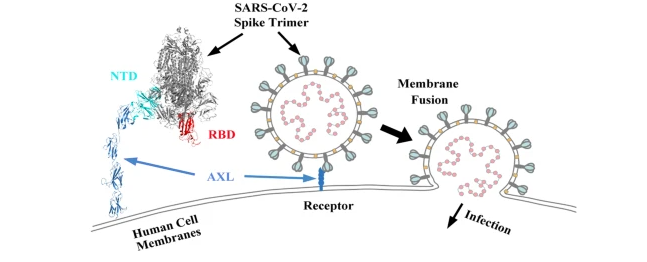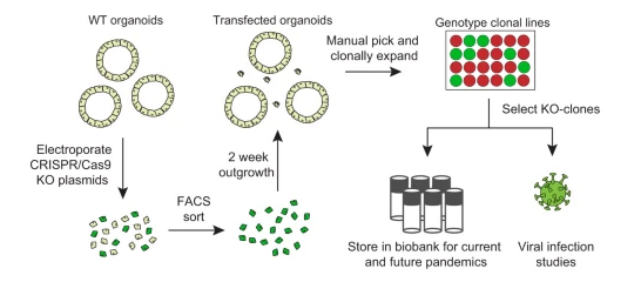How CRISPR helps to explore COVID-19 therapeutic targets?

A respiratory disease caused by severe acute respiratory syndrome coronavirus 2 (SARS-CoV-2), has become a global pandemic. At present, the outbreak of COVID-19 poses a serious threat to global public health. Since SARS-CoV-2 was first discovered, many researchers have focused their attention on studying this new coronavirus. CRISPR/Cas9, a technology for rapid and efficient DNA editing of targeted gene by sgRNA guided Cas9 nuclease, has become a tool for manipulating genomes in cells, animals and plants because of its high efficiency and versatility. So how is it applied to COVID-19 research? This article shares some latest researches of COVID-19 utilizing gene-edited cells. Hope you could enjoy it!
(1)AXL is a candidate receptor for SARS-CoV-2 that promotes infection of pulmonary and bronchial epithelial cells(Cell Research,IF=25.6176(2021))
It has been published that SARS-CoV-2 binds to the host receptor ACE2 through its spike (S) glycoprotein, which mediates membrane fusion and viral entry. Although the role of ACE2 as a receptor for SARS-CoV-2 is clear, studies have shown that ACE2 expression is extremely low in various human tissues, especially in the respiratory tract. Thus, other host receptors and/or co-receptors that promote the entry of SARS-CoV-2 into cells of the respiratory system may exist.
Recently, a study was published in Cell Research, it was reported that researchers combined proteomic calculation to find the host receptor with the highest binding affinity for SARS-CoV-2, and found that the tyrosine-protein kinase receptor UFO (AXL) specifically interacts with the N-terminal domain of SARS-CoV-2 S. To verify the important role of AXL in promoting the entry of SARS-CoV-2 into human cells, they used both a SARS-CoV-2 virus pseudotype and authentic SARS-CoV-2, and found that overexpression of AXL in HEK293T promotes SARS-CoV-2 entry as efficiently as overexpression of ACE2, while knocking out AXL significantly reduces SARS-CoV-2 infection in H1299 pulmonary cell line and in human primary lung epithelial cells. And soluble human recombinant AXL blocks SARS-CoV-2 infection in cells expressing high levels of AXL. Meanwhile, in order to determine the correlation between AXL expression and SARS COV-2 infection in COVID-19 patients, the researchers conducted single-cell mRNA sequencing of bronchoalveolar lavage fluid cells (BALF) of COVID-19 patients, and found that the expression level of AXL was closely related to the level of SARS-CoV-2 in BALF cells.
Taken together, their findings suggest that AXL is a novel candidate receptor for SARS-CoV-2 which may play an important role in promoting viral infection of the human respiratory system and indicate that it is a potential target for future clinical intervention strategies.
Ubigene not only constructs AXL KO A549 cell line/AXL KO HEK293 cell line and ACE2 KO Hela/16HBE cell line , but also provides the construction service of ACE2 overexpression stable cell lines (such as A549, HepG2, HeLa, etc.) to help the research of SARS-CoV-2. At present, our stable cell line service is in promotion, starting from $2020. Please contact us to assess your project >>

(2)Genome-wide CRISPR screening identifies TMEM106B as a proviral host factor for SARS-CoV-2(Nature Genetics,IF=38.3307(2021))
Recently, Dirk daelemans, Jim baggen and other researchers from the University of Leuven in Belgium cooperated to screen the whole genome CRISPR and found that TMEM106B is the proviral host factor of SARS-CoV-2. The research results have been published in the journal Nature Genetics.
Genome-wide CRISPR Screening has been widely used to identify host factors of various viruses, including coronaviruses such as SARS-CoV-2. To identify host factors essential for coronavirus infection, researches performed genome-wide functional genetic screens with SARS-CoV-2 and human coronavirus 229E. These screens uncovered virus-specific as well as shared host factors, including TMEM41B and PI3K type 3. They discovered that SARS-CoV-2 requires the lysosomal protein TMEM106B to infect human cell lines and primary lung cells. TMEM106B overexpression enhanced SARS-CoV-2 infection as well as pseudovirus infection, suggesting its role in viral entry. Furthermore, single-cell RNA-sequencing of airway cells from patients with COVID-19 demonstrated that TMEM106B expression correlates with SARS-CoV-2 infection. Overall, the present study uncovered a collection of coronavirus host factors that may be exploited to develop drugs against SARS-CoV-2 infection or future zoonotic coronavirus outbreaks.

(3)A CRISPR/Cas9 genetically engineered organoid biobank reveals essential host factors for coronaviruses(Nature communications,IF=14.9196(2021))
Rapid identification of host genes essential for virus replication may expedite the generation of therapeutic interventions. However, genetic screens are often performed in transformed cell lines that poorly represent viral target cells in vivo, leading to discoveries that may not be translated to the clinic. Intestinal organoids are increasingly used to model human disease and are amenable to genetic engineering. Based on this, researchers from Netherlands -- Bart L. Haagmans, Hans Clevers, etc developed an organoid biobank based on CRISPR/Cas9 technology to study the basic host factors of coronavirus.
To discern which host factors are reliable anti-coronavirus therapeutic targets, they generated mutant clonal Intestinal organoids (IOs) for 19 host genes previously implicated in coronavirus biology. They verified ACE2 and DPP4 as entry receptors for SARS-CoV/SARS-CoV-2 and MERS-CoV respectively. SARS-CoV-2 replication in IOs does not require the endosomal Cathepsin B/L proteases, but specifically depends on the cell surface protease TMPRSS2. But other TMPRSS family members were not essential. The newly emerging coronavirus variant B.1.1.7, as well as SARS-CoV and MERS-CoV similarly depended on TMPRSS2. These findings underscore the relevance of non-transformed human models for coronavirus research, identify TMPRSS2 as an attractive pan-coronavirus therapeutic target, and demonstrate that an organoid knockout biobank is a valuable tool to investigate the biology of current and future emerging coronaviruses.ACE2, DPP4, TMPRSS2 and FRUIN are important targets of coronavirus infection. These KO cell lines can be applied to various basic studies of virus invasion into human body. Ubigene provides a variety of KO cell lines in stock, such as ACE2 KO cell lines (Hela/16HBE), TMPRSS2/FRUIN KO cell lines (Hela), DPP4 KO cell lines (A549/HEK293), and nearly 3000 KOs in stock, starting from $1980, deliver in one week. Click to search for your KO cell line NOW >>

In order to help scientists to better carry out the basic research and drug R&D of SARS-CoV-2, Ubigene has developed a series of COVID-19 related cell products, including ACE2 overexpression stable cell lines, KO cell lines, vaccine development related cell lines and frequently used wild type cell lines for COVID-19 research. Ubigene has rich gene-editing experience and has exclusively developed CRISPR-U™ with higher gene-editing efficiency, and has provided thousands of gene-editing cell services for more than 20 countries and regions around the world. Welcome to contact us for more details.









